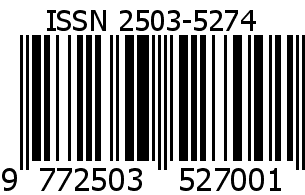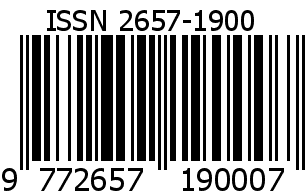INTERPRETASI JENIS BATUAN MENGGUNAKAN METODE GEOMAGNETIK PADA DAERAH TERAKUMULASINYA AIR TANAH DI BENA AMANUBAN SELATAN
Abstract
Abstrak
Telah dilakukan penelitian interpretasi jenis batuan menggunakan metode geomagnetik pada daerah terakumulasinya air tanah di Bena Amanuban Selatan. Tujuan penelitian ini untuk menentukan pemetaan anomali magnetik bawah permukaan dan pola penyebaran batuan di sekitar daerah terakumulasinya air tanah. Akuisisi data menggunakan Proton Precession Magnetometer (PPM) tipe GSM–19T. Hasil pengukuran data lapangan berupa nilai medan magnet total dan variasi harian yang diolah serta diinterpretasikan secara kualitatif dan kuantitatif. Interpretasi kualitatif menunjukkan tiga pola anomali, yaitu anomali tinggi, sedang dan rendah. Anomali tinggi (sekitar 105 nT sampai 140 nT) pada bagian selatan dan barat daya diduga berupa batuan lempung dan batugamping. Anomali sedang (sekitar 70 nT sampai <105 nT) yang mendominasi lokasi penelitian diduga batuan lempung dan batu pasir. Anomali rendah (sekitar 40 nT sampai <70 nT) di bagian timur diduga batu gamping dan batu pasir. Interpretasi kuantitatif menunjukan struktur batuan yang diduga akuifer yaitu batu pasir memiliki suseptibilitas 6.7 x 10-5 – 3.56 x10-4 pada kedalaman 22.8 m serta batugamping yang bersifat meluluskan air dengan suseptibilitas 5.792 x 10-3 – 9.247 x 10-3 dengan kedalaman 75 m. Selain kedua batuan tersebut, terdapat batuan lempung dengan suseptibilitas 7.28 x 10-4 – 1.063 x 10-3 di kedalaman 13.8 m.
Kata kunci: Metode geomagnetik, suseptibilitas, akuifer.
Abstract
An interpretation of rock types has been done using geomagnetic method in the area of accumulated groundwater in Bena Amanuban Selatan. The purpose of this study was to determine the mapping of subsurface magnetic anomalies and the pattern of rock distribution around the accumulated groundwater area. Data acquisition using Proton Precession Magnetometer (PPM) type GSM-19T. The results of field data measurements in the form of total magnetic field value and daily variations are processed and interpreted qualitatively and quantitatively. Qualitative interpretation shows three patterns of anomalies, namely high anomalies, moderate and low. High anomalies (about 105 nT to 140 nT) in the south and southwest are thought to be clay and limestone. Moderate anomalies (about 70 nT to <105 nT) that dominate the study sites are suspected clay and sandstone. Low anomalies (about 40 nT to <70 nT) in the eastern part are suspected of limestone and sandstone. Quantitative interpretation shows the suspected aquifer rock structure of sandstone has a susceptibility of 6.7 x 10-5 – 3.56 x10-4 at a depth of 22.8 m as well as a water-grinding limestone with the susceptibility of 5.792 x 10-3 – 9.247 x 10-3 with a depth of 75 m. In addition to these two rocks, there are clay rocks with the susceptibility of 7.28 x 10-4 – 1.063 x 10-3 at depth of 13.8 m.
Keywords: Geomagnetic method, susceptibility, aquifer.
Downloads
Copyright (c) 2018 Jurnal Fisika : Fisika Sains dan Aplikasinya

This work is licensed under a Creative Commons Attribution-NonCommercial-ShareAlike 4.0 International License.
Jl. Adisucipto, Penfui-Kupang, Lasiana, Klp. Lima, Kota Kupang, Nusa Tenggara Timur., Indonesia
This work is licensed under Attribution-NonCommercial-ShareAlike 4.0 International (CC BY-NC-SA 4.0)
 Yohanes Takaeb(1)
Yohanes Takaeb(1)



















